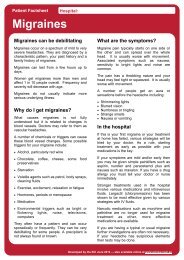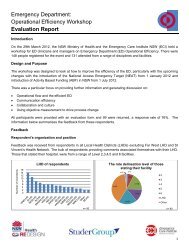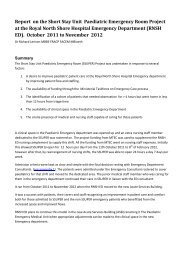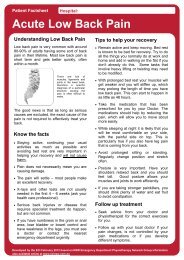Facilitators Manual - Emergency Care Institute
Facilitators Manual - Emergency Care Institute
Facilitators Manual - Emergency Care Institute
Create successful ePaper yourself
Turn your PDF publications into a flip-book with our unique Google optimized e-Paper software.
ACTIVITY 24Discuss with participant as required or appropriate.Q1. Briefly describe the pathophysiology of cardiogenic pulmonary oedema.An increase in the pulmonary venous pressure shifts the balance of forces between the capillaryand the interstitium. Hydrostatic pressure increases and fluid exits the capillary at an increased rate,resulting in interstitial and, in more severe cases, alveolar oedema.ACTIVITY 25With your facilitator or support person, auscultate the chest of a patient with pulmonary oedema.Discuss.Sign off skill set relevant to activity in participant’s workbook if mastery obtained, answer anyquestions participants may have.ACTIVITY 26Discuss with participant.Q1. Describe the signs and symptoms of a large pneumothorax.Symptoms of pneumothoraces include dyspnoea and pleuritic chest pain. Dyspnoea may be suddenor gradual in onset depending on the rate of development and size of the pneumothorax. Pain cansimulate pericarditis, pneumonia, pleuritis, pulmonary embolism, musculoskeletal injury (when referredto the shoulder), or an intra-abdominal process (when referred to the abdomen). Pain can also simulatecardiac ischemia, although typically the pain of cardiac ischemia is not pleuritic.Physical findings classically consist of absent tactile fremitus, hyperresonance to percussion, anddecreased breath sounds on the side with the pneumothorax. If the pneumothorax is large, the side withthe pneumothorax may be enlarged with the trachea visibly shifted to the opposite side. With tensionpneumothorax, hypotension can occur.17Q2. List the potential interventions to evacuate the air in a person with a large pneumothorax.Aspiration of the air with a needle.Placement of a percutaneous catheter attached to a Heimlich valve.Insertion of a thoracic vent.Insertion of a chest tube with underwater-seal suction drainage.Q3. Identify the key nursing interventions required to maintain a chest tube system.Prevent kinks and large loops of tubing to facilitate drainage and air evacuation.Observe water seal chamber for unexpected bubbling indicating an air leak.Assess patient to identify potential complications.Monitor drainage.ACTIVITY 27With your facilitator or support person, identify the chest tube system used at your facility. Discussand demonstrate how to set it up and the observations that need to be attended for a patient witha chest tube.Answer any questions that the participant may have.
















